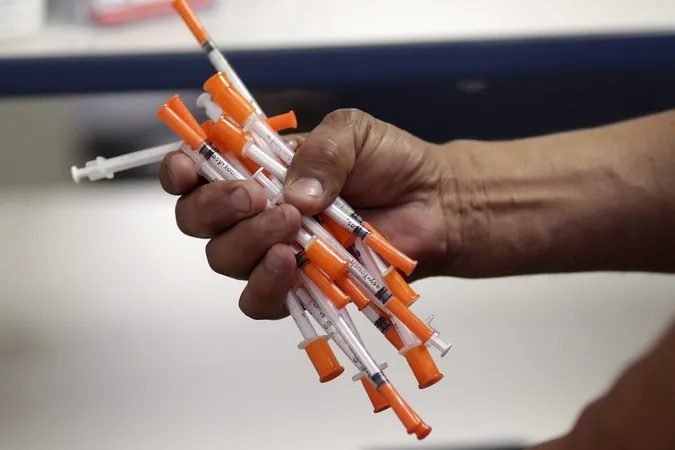
Boosting Health and Cutting Costs: Canada’s Underused Prison Needle-Exchange Programs
2024-12-16
Author: Olivia
Introduction
A groundbreaking study featured in the Canadian Medical Association Journal has revealed that for every dollar invested in prison needle-exchange programs (PNEPs) in Canada, an impressive $2 is saved on treatment costs for hepatitis C and other injection-related infections. This compelling finding calls attention to the economic and health benefits of such programs, yet they remain alarmingly underutilized within correctional facilities.
Overview of Canada’s PNEPs
Introduced in 2018, Canada’s PNEPs were established in nine out of 43 federal institutions, later expanding to three additional locations. These programs offer inmates sterile needles and equipment kits to combat the risks associated with needle sharing, particularly the transmission of blood-borne diseases. However, according to the latest findings, only about 10% of incarcerated individuals who use drugs took advantage of these programs at the initial sites in 2022. Surprisingly, even at this low participation rate, the correctional system is still saving money.
Call for Expansion
Dr. Nadine Kronfli, an infectious disease expert from McGill University Health Centre and a co-author of the study, emphasized the importance of scaling up these initiatives. Canada is currently one of just nine countries that have adopted PNEPs, but Kronfli warns that the country risks falling behind without a renewed commitment to improving and expanding these services. "We need to lead rather than stagnate," she stated, highlighting the urgency to enhance the effectiveness of these programs.
Funding and Quality Improvement
Kronfli has recently secured a $1.1 million grant from the Canadian Institutes of Health Research, aimed at increasing enrollment in the initial nine prisons and elevating the quality of the programs. The focus is clear: improving prisoner health and, in turn, reducing the risk of spreading infections post-release.
Government Criticism
Sadly, the Canadian federal government has received increasing criticism for its sluggish approach to implementing harm-reduction measures in prisons. Organizations, including the Correctional Investigator Ivan Zinger and various prisoner advocacy groups, have condemned this delay. Zinger indicated that Correctional Services Canada has shown reluctance to fully implement programs like PNEPs, which are crucial for addressing drug-related hazards within correctional environments.
Financial Implications
In terms of financial implications, study co-author Nick Scott from the Burnet Institute in Australia revealed that treating hepatitis C and related infections can cost anywhere from $14,000 to $20,000 per inmate. PNEPs, therefore, serve as a critical preventive measure, potentially reducing these significant expenditures even further.
Current Participation Challenges
Despite the potential for impact, the latest reports from The Globe and Mail indicate that as of November 2022, only 326 inmates across Canada were approved to participate in needle-exchange initiatives, with only a small fraction actively using the program. Dr. Kronfli noted several barriers to wider implementation, including lack of endorsement from senior prison leadership, inconsistent program rollout, and stringent eligibility criteria. Inmates must undergo a risk assessment to gain approval for the program, and more than a quarter of applicants are rejected based on past behavior and perceived threats.
Political Opposition
Political attitudes toward needle-exchange programs add an additional layer of complexity. Raquel Dancho, the Conservative Party's public safety critic, has spoken out against the initiative, arguing that inmates should not receive needles but rather be directed towards drug treatment programs. She raised concerns about the safety of correctional officers and inmates, claiming that such measures could facilitate access to illegal drugs within prison walls.
Conclusion
As Canada stands on the cusp of transforming its approach to drug use in prisons, the urgent question remains: will the federal government act on the evidence and expand these life-saving programs before it's too late?









 Brasil (PT)
Brasil (PT)
 Canada (EN)
Canada (EN)
 Chile (ES)
Chile (ES)
 España (ES)
España (ES)
 France (FR)
France (FR)
 Hong Kong (EN)
Hong Kong (EN)
 Italia (IT)
Italia (IT)
 日本 (JA)
日本 (JA)
 Magyarország (HU)
Magyarország (HU)
 Norge (NO)
Norge (NO)
 Polska (PL)
Polska (PL)
 Schweiz (DE)
Schweiz (DE)
 Singapore (EN)
Singapore (EN)
 Sverige (SV)
Sverige (SV)
 Suomi (FI)
Suomi (FI)
 Türkiye (TR)
Türkiye (TR)